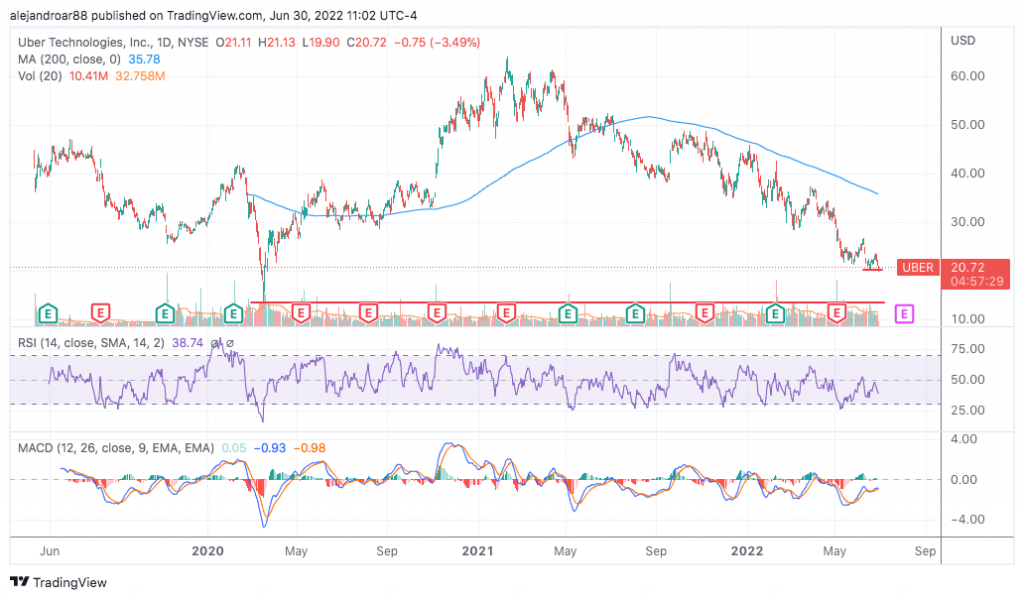Uber Stock Down 13% in June – Time to Buy UBER Stock?
Please note that we are not authorised to provide any investment advice. The content on this page is for information purposes only.

The price of Uber stock has declined 13% so far this month as macroeconomic conditions in the United States and across continue to deteriorate due to persistent inflationary pressures.
Earlier this month, the Federal Reserve decided to increase its benchmark interest rate by 75 basis points to a range between 1.5% and 1.75% while officials from the central bank have made several hawkish comments in regards to the country’s monetary policy.
Higher interest rates typically lead to a drop in equity valuations as inflows tend to favor low-risk assets in this environment while expected returns for high-risk asset classes rise.
This is an unfavorable backdrop for stocks of companies whose fundamentals are not that strong as is the case of Uber. In this regard, the ride-hailing company continues to struggle to produce meaningful profits and cash flow out of its large revenues and that increases uncertainty in the short to mid-term as the company will eventually be forced to refinance its debt at less favorable terms.
In addition, some company-specific headwinds such as rising gasoline prices are threatening to disrupt Uber’s business model as well since fares have continued to rise so drivers can cover their operating expenses
In this particular environment, what does the future hold for this tech stock? In this article, I’ll be assessing the price action and fundamentals of Uber stock to outline plausible scenarios for the future.
Uber Stock – Technical Analysis

At some point this morning, Uber stock drifted to its lowest level in 2022 but has temporarily recovered above the $20 level as momentum for equities continues to be on the negative side.
Just yesterday, the Chairman of the Federal Reserve, Jerome Powell, made several concerning statements during a panel with other central bankers.
“The economy is being driven by very different forces. What we don’t know is whether we’ll be going back to something that looks like, or a little bit like, what we had before”, was one of the most remarkable comments regarding the situation of the US economy after the pandemic.
In addition, Powell summarized how uncertain the outlook was by stating: “I think we now understand better how little we understand on inflation”.
Also read: Cathie Wood Continues to Remain bullish on Tesla while Slashing Other Stocks
Those phrases have failed to reassure market participants in regards to what the Fed may have to do to keep prices from spiraling out of control. This means that multiple extreme measures remain on the table including quantitative tightening and further interest rate hikes.
In this uncertain environment, the outlook for equities, and even more so for those within the tech sector like Uber stock, remains negative.
Moving forward, if the price of UBER slides below the $20 threshold chances are that the stock could retest its 2020 pandemic lows of around $14 per share resulting in a 30% downside risk in the near term.
Momentum indicators are favoring this view as the Relative Strength Index (RSI) is on a downtrend while the MACD remains neck-deep into negative territory.
Uber Stock – Fundamental Analysis
For market participants, financial stability and cash flows are kings in the current environment – not growth.
The reason for this is that the consensus opinion in regards to the future of the US economy is that the Federal Reserve’s contractionary actions will lead to a recession. Meanwhile, high gasoline prices will continue to increase the price of Uber rides and may hurt the demand for this service.
In response, Uber recently reintroduced its ride-sharing feature as a way to alleviate the cost of taking a ride for passengers.
During the first quarter of 2022, the company managed to reduce its cash burn significantly. In this regard, negative free cash flows back then stood at $47 million compared to minus $682 million the firm reported during the same period a year ago.
Also read: Is Peloton Stock a Buy After a 22% Drop in June?
In addition, the firm had total cash and equivalents of $4.2 billion in addition to $6.25 billion in investments including its stakes in various large businesses such as Didi Global and Aurora. Meanwhile, the firm’s solvency is not a concern at the moment as maturities won’t hit until three years for now.
Based on the market’s forecasts for Uber’s revenues for the next 12 months, the firm is trading at a forward P/S ratio of 1.3x.
This is one of the lowest multiples at which the firm has traded for years but it might be justified in an environment as uncertain as the current one. In addition, Uber has not yet proved that it can generate decent profits and cash flows out of its business and that will continue to weigh on the firm’s valuation unless the Fed’s pandemic-era accommodative policies make a comeback – which seems highly unlikely at the moment.
All things considered, Uber’s $40.5 billion price tag at the moment seems fair based on the number of users the platform caters to, its intellectual property, and innovative business model.
Whether the upside potential in the mid to long-term is promising or not remains unclear as this largely depends on how macroeconomic conditions evolve and on the business’s ability to reach a point in which it can start generating decent profits.
Other Related Articles:





